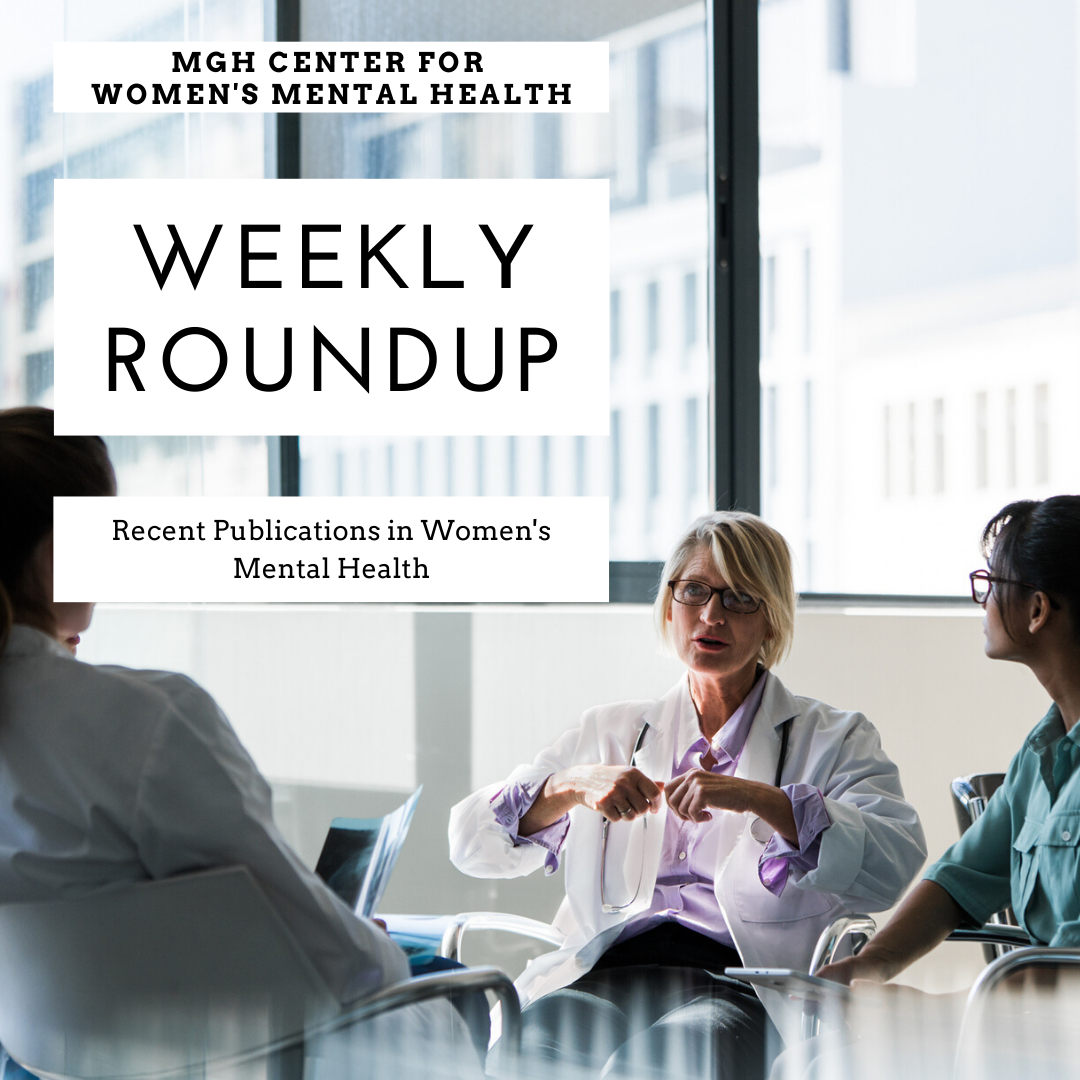PMS AND PMDD
|
|
No articles this week
|
INFERTILITY AND MENTAL HEALTH
|
|
No articles this week
|
PSYCHIATRIC ILLNESS DURING PREGNANCY
|
|
Obstetric complications in mothers with ADHD.
Walsh CJ, Rosenberg SL, Hale EW. Front Reprod Health. 2022 Nov 7;4:1040824.
Compared to the group without ADHD, mothers with ADHD had higher rates of every outcome except for HPV infection. The odds ratios ranged from 1.08 for anemia complicating pregnancy to 2.63 for depressive episodes.
Long-term effects of a prenatal mindfulness intervention on depressive symptoms in a diverse sample of women.
Roubinov DS, Epel ES, Coccia M, Coleman-Phox K, Vieten C, Adler NE, Laraia B, Bush NR. J Consult Clin Psychol. 2022 Nov 28.
Depressive symptoms at all follow-up assessments through 8 years were significantly lower among women in MIND group compared to TAU. The odds of moderate or higher depressive symptoms were greater among TAU compared to MIND women at all time points except the 6-year assessment. By Year 8, 12% of women in MIND reported moderate or more severe depressive symptoms compared to 25% of women in TAU.
|
MEDICATIONS AND PREGNANCY
|
|
Adverse fetal and neonatal outcomes following in-utero exposure to oxcarbazepine: A systematic review and meta-analysis.
Athar F, Ehsan M, Farooq M, Lo KB, Cheema HA, Ahmad S, Naveed A, Umer M.
Br J Clin Pharmacol. 2022 Aug;88(8): 3600-3609.
The summary odds ratio (OR) was 1.69 (95% CI, 0.95-2.98) for congenital malformations following in-utero exposure to oxcarbazepine as compared to the control group of unexposed patients (seven studies [n = 625]), and was 1.19 (95% CI, 0.67-2.12) when compared to those following lamotrigine (LTG) exposure during pregnancy (3 studies [n = 591]). In total, three studies (n = 770) reported the association between in-utero oxcarbazepine exposure and fetal/perinatal deaths, estimating a summary OR of 3.33 (95% CI, 1.70-6.51).
|
|
Association of Prenatal Exposure to Antiseizure Medication With Risk of Autism and Intellectual Disability.
Bjørk MH, Zoega H, Leinonen MK, Cohen JM, Dreier JW, Furu K, Gilhus NE, Gissler M, Hálfdánarson Ó, Igland J, Sun Y, Tomson T, Alvestad S, Christensen J. JAMA Neurol. 2022 Jul 1;79(7):672-681.
The adjusted hazards ratios (aHRs) for ASD and intellectual disability (ID) after topiramate exposure were 2.8 (95% CI, 1.4-5.7) and 3.5 (95% CI, 1.4-8.6), respectively, and after valproate exposure were 2.4 (95% CI, 1.7-3.3) and 2.5 (95% CI, 1.7-3.7). No consistently increased risks were observed for neurodevelopmental disorders after prenatal exposure to monotherapy with lamotrigine, levetiracetam, carbamazepine, oxcarbazepine, gabapentin, pregabalin, clonazepam, or phenobarbital.
|
|
In utero antidepressant exposure not associated with ADHD in the offspring: A case control sibling design.
Hartwig CAM, Robiyanto R, de Vos S, Bos JHJ, van Puijenbroek EP, Hak E, Schuiling-Veninga CCM. Front Pharmacol. 2022 Nov 10;13:1000018.
|
|
Association of Maternal Antipsychotic Prescription During Pregnancy With Standardized Test Scores of Schoolchildren in Denmark.
Liu X, Trabjerg BB, Munk-Olsen T, Christensen J, Dreier JW. JAMA Intern Med. 2022 Oct 1;182(10):1035-1043.
In this register-based cohort study, maternal prescription fill for antipsychotics during pregnancy did not appear to be associated with standardized test scores in the offspring.
|
|
Selective serotonin reuptake inhibitors and preeclampsia: A quality assessment and meta-analysis.
Gumusoglu SB, Schickling BM, Vignato JA, Santillan DA, Santillan MK. Pregnancy Hypertens. 2022 Dec;30:36-43.
The pooled risk ratio (random effects model) was 1.43 (95 % CI: 1.15-1.78, P < 0.001; range 0.96-4.86). Despite evidence for increased preeclampsia risk with SSRIs, shared risk factors and other variables are poorly controlled.
Neurodevelopment in school-aged children after intrauterine exposure to antipsychotics.
Schrijver L, Robakis TK, Kamperman AM, Bijma H, Honig A, van Kamp IL, Hoogendijk WJG, Bergink V, Poels EMP.
Acta Psychiatr Scand. 2022 Nov 4.
No statistically significant associations were found between antipsychotic exposure during pregnancy and either adverse neurodevelopmental outcomes (IQ, neuropsychological function), likelihood of psychiatric diagnosis, or learning problems based on parental report.
|
|
Antipsychotic Use in Early Pregnancy and the Risk of Maternal and Neonatal Complications.
Lin HY, Lin FJ, Katz AJ, Wang IT, Wu CH. Mayo Clin Proc. 2022 Nov;97(11):2086-2096.
Using antipsychotics in early pregnancy did not result in a greater risk of metabolic complications for either mothers and newborns
|
| |
POSTPARTUM PSYCHIATRIC ILLNESS
|
|
Prevention of perinatal depression with counseling in adolescents: a cost-effectiveness analysis.
Franta G, Hersh AR, Cirino NH, Caughey AB. J Matern Fetal Neonatal Med. 2022 Dec;35(25):9593-9599.
A strategy of referral to counseling interventions was cost effective in our theoretical cohort, with 8935 fewer cases of perinatal depression, 1606 fewer cases of chronic depression, 166 fewer preterm deliveries.
The PPD-ACT app in Canada: feasibility and a latent class analysis of participants with postpartum depression recruited to a psychiatric genetics study using a mobile application.
Collaton J, Dennis CL, Taylor VH, Grigoriadis S, Oberlander TF, Frey BN, Van Lieshout R, Guintivano J, Meltzer-Brody S, Kennedy JL, Vigod SN. BMC Psychiatry. 2022 Nov 24;22(1):735. Free article.
|
MEDICATIONS AND BREASTFEEDING
|
|
No articles this week
|
PERINATAL SUBSTANCE USE
|
|
No articles this week
|
MATERNAL MENTAL HEALTH AND CHILD OUTCOMES
|
|
Maternal depressive symptoms, neonatal white matter, and toddler social-emotional development.
Lautarescu A, Bonthrone AF, Pietsch M, Batalle D, Cordero-Grande L, Tournier JD, Christiaens D, Hajnal JV, Chew A, Falconer S, Nosarti C, Victor S, Craig MC, Edwards AD, Counsell SJ. Transl Psychiatry. 2022 Aug 9;12(1):323.
Perinatal depressive symptoms are associated with neonatal uncinate fasciculi microstructure, but not fibre bundle size, and toddler behavior.
|
|
Birth of the blues: emotional sound processing in infants exposed to prenatal maternal depression.
Craig MC, Sethna V, Gudbrandsen M, Pariante CM, Seneviratne T, Stoencheva V, Sethi A, Catani M, Brammer M, Murphy DGM, Daly E. Psychol Med. 2022 Aug;52(11):2017-2023.
Using functional magnetic resonance imaging, researchers observed differences in brain function, while listening to emotional sounds, in 78 full-term infants (3-6 months of age) born to mothers with and without a diagnosis of prenatal depression.
Association between diagnosed perinatal mood and anxiety disorders and adverse perinatal outcomes.
Accortt E, Mirocha J, Jackman S, Coussons-Read M, Dunkel Schetter C, Hobel C. J Matern Fetal Neonatal Med. 2022 Dec;35(25):9066-9070.
A diagnosis or perinatal mood and anxiety disorder was associated with 3.5 times higher odds of having an adverse perinatal outcome. For every 5 years a woman aged or every five units her BMI increased her odds of having an adverse perinatal outcome increased. Older age and increased BMI are well established adverse perinatal outcome risk factors.
|
MENOPAUSE AND MENTAL HEALTH
|
|
No articles this week
|
OTHER TOPICS IN WOMEN’S MENTAL HEALTH
|
|
No articles this week
|
|




Leave A Comment